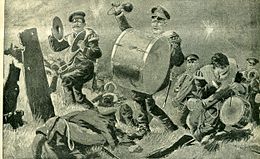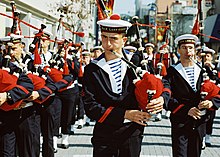Martial music
| Part of a series on |
| War |
|---|


Martial music or military music is a specific genre of music intended for use in military settings performed by professional soldiers called field musicians. Much of the military music has been composed to announce military events as with
Types
March music

The notion of march music began to be borrowed from the
Marching songs
Marching songs, typically with patriotic and sometimes nostalgic lyrics, are often sung by soldiers as they march. The songs invariably feature a rhythm timed to the
Bugle calls
The
Ruffles and flourishes
Ruffles and flourishes are
Recorded music
The
Instruments

Historically,
Drum
Chinese troops used
Trumpet

The earliest trumpets were signaling instruments used for military or religious purposes and the modern bugle continues this signaling tradition.
Officers in command gave orders via sound from the trumpet because it had a piercing tone and high volume, which meant it could be heard in the midst of combat. Cavalry trumpets had a different timbre, so their calls would not be mistaken for other sounds meant for the infantry.

Bagpipe
An instrument with a piercing sound and graceful melody which is meant to be played outdoors, its main goal is to inspire men and women in the midst of conflict. It is also used in mourning the fallen and celebrating victory. Music was played in the build up to battle, but not during.[4]
Textual evidence for the use of Scottish bagpipes in battle dates from in 1396, when records of the
Also see:
Shawm

One of several woodwind instruments used in battle as early as the 12th century. This instrument rose in popularity during the Renaissance period and is believed to be a successor of an instrument called the zurna. It was mostly used as a military instrument. The overpowering noise coming from this instrument was used as a psychological weapon. The shawm found its way to Europe during the Crusades. [8]
See also
- Battle cry
- Martial industrial
- March music
- Military band
- War song
- Royal Artillery Band
- British Grenadiers March
- Henry George Farmer
- Kneller Hall
References
- ^ White, William (1944). A History of Military Music in America. Westport: Greenwood Press. p. 50.
- ^ Jonathan Pieslak, Sound Targets: American Soldiers and Music in the Iraq War, published by Indiana University Press, 2009.
- ^ Beviglia, Jim (29 June 2015). "Lyric of the Week: Dire Straits, "Brothers in Arms"". Archived from the original on 24 March 2016. Retrieved 12 September 2022.
- ^ Manson, William (1977). The Highland Bagpipe, Its History, Literature, and Music. EP Publishing. p. 115.
- ^ Francis Collinson, The Bagpipe, London and Boston: Routledge & Kegan Paul, 1975, pp. 126, 135.
- ^ De Rebus Hibernicis by Richard Stanihurst, quoted in Sean Donnelly, "The Warpipes in Ireland: iii", Ceol: A Journal of Irish Music, April 19, 1983, pp. 19-23.
- ^ Claire Barrett (6/12/2023) ‘Ladies from Hell’: Bagpipers Led the Charge During WWI. HistoryNet Retrieved from https://www.historynet.com/ladies-from-hell-bagpipers-led-the-charge-during-wwi/.
- ^ Baines, Anthony (1963). Woodwind instruments and their history. New York: W.W. Norton.
Further reading
- Mark A. Snell and Bruce C. Kelley, editors, Bugle Resounding: Music and Musicians of the Civil War era, National Conference on Music of the Civil War Era, 2004.
- Lee Andresen, Battle Notes: Music of the Vietnam War, Savage Press, 2003.
- John H. Beck, Encyclopedia of Percussion, Routledge Press, 2007.
